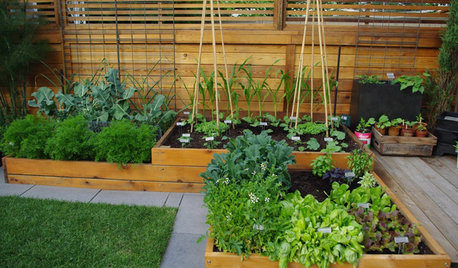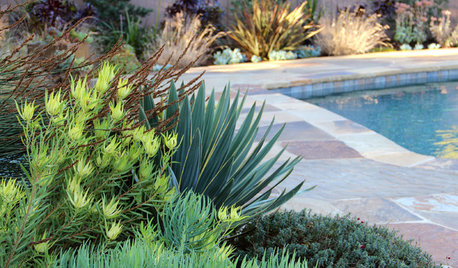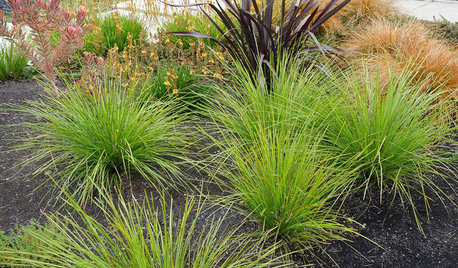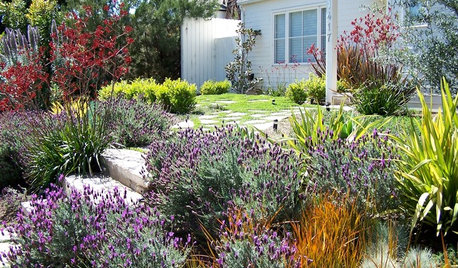Drought and watering, request your experiences
melissa_thefarm
12 years ago
Featured Answer
Comments (35)
imagardener2
12 years agolast modified: 9 years agoRelated Discussions
Big fines considered for Californian's overusing water in drought
Comments (50)Odinthor's essential point is right on, but it should be noted that the EPA figures cited are for the U.S. as a whole. For the U.S. as a whole, the percentage of water used for agriculture/irrigation (which are the same and do not include watering residential yards) is a relatively lower percentage than in CA because crop irrigation is most intensely used in the western U.S. and not so much elsewhere. The percentage the EPA gives for thermoelectric power is again for the U.S. as a whole and is a vastly greater percentage than the actual one for California since most of California's power generation use sea water for this purpose and relatively little from freshwater sources. (see comparisons for this at link below). U.C. Davis estimates for "developed" water use (i.e., that which is captured or otherwise accessed for human use) in California have roughly 80% going to agriculture/irrigation, 10% municipal or "domestic" use, and 10% for all other uses, to use round figures (these figures are also given in this Wikipedia article: http://en.wikipedia.org/wiki/Water_in_California). Alfalfa and livestock forage are almost always the two biggest uses of water in CA, with rice and cotton often in positions 3 and 4 (sugar beets frequently a biggie, too). The fruits and vegetables Jeri mentions, all of California's other crops, each take relatively small shares compared to the top four. So, as Odinthor points out, a relatively minor percentage of savings in ag has far more potential for big reductions in overall water use than even the most draconian cuts in domestic water use (or, in the case of California, all other uses of water combined). Too true about lack of regulation of ground water -- it's still like the old wild West on that front. Along with the problems of depletion and degradation of the aquifers themselves, land elevations in parts of the the San Joaquin Valley have actually sunk by 24 feet or more due to subsidence caused by ground water overdraft. (http://pubs.usgs.gov/circ/circ1182/pdf/06SanJoaquinValley.pdf) That said, it's still a sin to let water run down the gutter or use it frivolously, especially this year. Here is a link that might be useful: Thermoelectric water use...See MoreDrought - How are you conserving water?
Comments (40)Well, I'm feeling a bit ornery today so bear with me. The water crisis this area is facing didn't happen overnight - and many have debated the 'blame' ad nauseam. What galls me is that topics such as bathroom behavior and flushing etiquette are now mainstream and this is just not right. I can deal with 'no sprinklers, no car washing, no hose watering' but when the powers that be start telling me how to brush my teeth or flush my toilet I get ornery. That the governor's wife does 'public service messages' on tv about dish and clothes washers is just too over the top! How humilitaing is that? Humiliating for her and insulting to the populace. Personal hygiene is not a news item. A poster above alluded to personal 'time of the month' issues - this has no place in public rhetoric and the circumstances that led to that defensive post are just wrong. Not the post or poster, the circumstances, please don't read me wrong. Personally, I'm dealing with a life threatening illness and no way, no how is any politician or newspaper article going to alter my personal care criteria for the 'water cause'. I didn't create this mess - have always been very conservative. But I'm not going to compromise 'for the public good' - I'm going to take care of myself first. So there. And I will keep my gardens alive - by hook or by crook. I installed rain barrels, hardscaping and drought tolerant plantings way, way before it was 'fashionable' - I've done my part. So there, again....See MoreYour experience with smoke and drought
Comments (12)Roses can habituate to summer drought, of course: ours go two months with no water without particular difficulty, as does the rest of the garden. This is with clay soil and lots of mulch and living ground cover (grass and weeds), warm to hot during the day, not so hot at night. I don't know if it would be worse to have such a drought in fall, and can't speak to the effects of smoke. Also we don't have much experience of winter cold, as temperatures below the high twenties are rare. Oddly enough, with all our woods and dry weather, I've never heard of fires locally. Of course, though roses survive drought well if they get water at other seasons, they stop blooming. Do you need to be worried about your roses? I'm not sure. We've had a dry fall ourselves, coming off a dry summer. It rains just enough to keep the ground moist, but amounts are below average and I'm wondering about the state of groundwater levels. The frequent fogs and humid weather, even if it doesn't actually rain that much, probably help prevent drought stress. In our Mediterranean fashion the annual grass is growing nicely. Still I keep waiting for real rain....See MoreRetain water? Drought tolerant Irrigation?
Comments (12)Sounds like you want to reduce the water that comes from some of the sprinklers on a shared circuit. First you should maximize your day interval. In my experience you can cut your lawn watering frequency to once every 3rd day, more than that and the soil gets too dry and water runs off etc. You should also have 2 start times an hour apart - splitting the total watering time between them. Ideally you have separate circuits, but without that you can use different spray heads on the same circuit, some spray heads have higher flow rates than others, so use low flow on your xeriscape and high flow on your grass. I have never combined drip lines and Sprinklers on the same circuit, there may be water pressure issues besides the obvious difference in desired run times. If you can get a drip line with all 4 gallon per hour drippers then it might put a useful amount of water out in 15 minutes.. versus the usual 1 hour for 1 gph drippers...See Moreingrid_vc so. CA zone 9
12 years agolast modified: 9 years agomad_gallica (z5 Eastern NY)
12 years agolast modified: 9 years agomariannese
12 years agolast modified: 9 years agoCampanula UK Z8
12 years agolast modified: 9 years agojacqueline9CA
12 years agolast modified: 9 years agorosemeadow_gardener
12 years agolast modified: 9 years agomelissa_thefarm
12 years agolast modified: 9 years agomichaelg
12 years agolast modified: 9 years agodaisyincrete Z10? 905feet/275 metres
12 years agolast modified: 9 years agomichaelg
12 years agolast modified: 9 years agoingrid_vc so. CA zone 9
12 years agolast modified: 9 years agomichaelg
12 years agolast modified: 9 years agolandperson
12 years agolast modified: 9 years agoingrid_vc so. CA zone 9
12 years agolast modified: 9 years agolandperson
12 years agolast modified: 9 years agolandperson
12 years agolast modified: 9 years agoluxrosa
12 years agolast modified: 9 years agomariannese
12 years agolast modified: 9 years agobart_2010
12 years agolast modified: 9 years agogreybird
12 years agolast modified: 9 years agoingrid_vc so. CA zone 9
12 years agolast modified: 9 years agolucretia1
12 years agolast modified: 9 years agocollinw
12 years agolast modified: 9 years agobart_2010
12 years agolast modified: 9 years agomelissa_thefarm
12 years agolast modified: 9 years agomichaelg
12 years agolast modified: 9 years agomelissa_thefarm
12 years agolast modified: 9 years agomichaelg
12 years agolast modified: 9 years agomelissa_thefarm
12 years agolast modified: 9 years agomad_gallica (z5 Eastern NY)
12 years agolast modified: 9 years agobart_2010
12 years agolast modified: 9 years agomelissa_thefarm
12 years agolast modified: 9 years agocath41
12 years agolast modified: 9 years ago
Related Stories

URBAN GARDENSExperiments Aplenty Fill Vancouver Edible Garden
Lush and brimming with test landscape plantings, a Canadian garden appeals to the eye and the palate
Full Story
HOUZZ TOURSHouzz Tour: A Hard-to-Find Door Just Adds to the Experience
A roundabout entry allows guests to fully enjoy this modern cedar box perched over a creek in Austin, Texas
Full Story
SAVING WATER11 Ways to Save Water at Home
Whether you live in a drought-stricken area or just want to help preserve a precious resource, here are things you can do to use less water
Full Story
PLANTING IDEAS7 Stunning Plant Combinations for Low-Water Gardens
Find inspiration in these beautiful drought-tolerant companion plantings
Full Story
GRASSESVersatile Breeze Mat Rush Sails Into Drought-Tolerant Yards
Grassy Lomandra longifolia thrives year-round in shady and sunny gardens, in containers and in the ground
Full Story
GARDENING GUIDES10 Drought-Tolerant Shrubs That Thrive in Full Sun and Reflected Heat
Got a hot spot in your garden where plants often die? Try these tough shrubs that add beauty while shrugging off the heat
Full Story
LIFEThe Top 5 Ways to Save Water at Home
Get on the fast track to preserving a valuable resource and saving money too with these smart, effective strategies
Full Story
LANDSCAPE DESIGNGet Along With Less Lawn — Ideas to Save Water and Effort
Ditch the mower and lower your water bill while creating a feast for the eyes with diverse plantings and gathering places
Full Story
SAVING WATERGreat Plants for Lush, Low-Water Gardens
Water restrictions making your garden look washed out? Give it living color with unthirsty grasses, flowers and succulents
Full Story
GARDENING GUIDESEssential Watering Tips for Your Edible Garden
To give your edible plants just what they need, check out these guidelines for how, when and how much to water
Full Story





catsrose